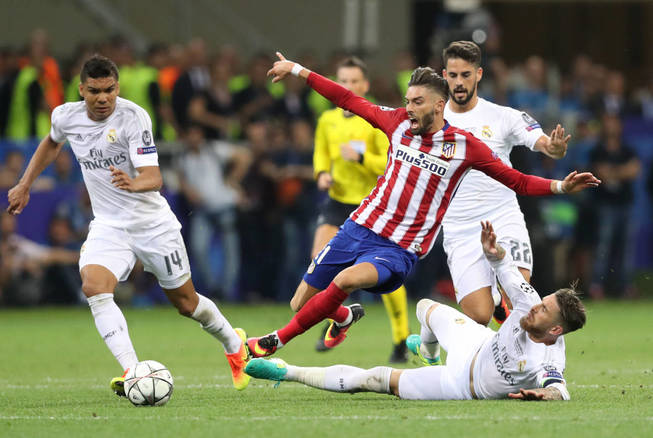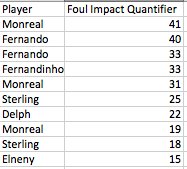
By Karthik (@thinktankkv)
When Sergio Ramos brought down Yannick Ferreira Carrasco in the Champions League final this year to put an end to a promising Atletico Madrid counter attack, a lot must have been going through his head. Carrasco was playing out of his skin trying to get Atletico back into the game and with two deft touches he managed to motor past Modric and Casemiro to leave Real Madrid’s defense in total disarray. Things looked good for Atletico at that instant; Carrasco had only one defender separating him from the goal and two of his teammates were quick to flank him on either side to create a numerical advantage. Ramos surveyed the situation and in a matter of seconds came up with solutions and assessed the risk involved in all possible courses of action. He could track back as fast as possible banking on Atletico to commit a mistake somewhere or he could take matters into his own hands and tactical foul Carrasco to put a permanent end to the counter. Ramos chose the latter and got a yellow card for it. It was a tradeoff he was more than happy to make.
Tactical fouls have always been an integral part of football. Central Midfielders and Defenders frequently resort to fouling opponents to get out of sticky situations. Like Ramos, Mikel Arteta was among the major proponents of the tactical foul and he used it to great effect throughout his Arsenal career in a Defensive Midfield role. He lacked the pace to recover from difficult situations and was clever in his use of fouls as a damage control option. Fouling opponents is an underrated action from a defensive point of view. It destroys the opponents’ rhythm and momentum, which is extremely important in constructing attacks, and also allows the defending team time to recover. The opponent is reduced to taking set pieces, which are widely accepted to not be an optimal mode of attack. With all these advantages, it is easy to see why players tend to indulge in low risk fouls to stall opponents as long as they are not on a yellow card.
When judging the defensive contribution of players, the value of tactical fouls they commit is often overlooked. Unlike interceptions and tackles, the impact of tactical fouls in match is difficult to compute and can be a complex process. To understand the difference a tactical foul makes, a method to quantify the impact of a foul is needed. One metric that can be employed to estimate the value of fouls is the Foul Impact Quantifier. This is a statistical tool that computes the impact of fouls from a defensive point of view. Below is a table containing Foul Impact Quantifier values for the major fouls in Arsenal’s 3-2 preseason win against Manchester City. It was a game where the referee was quite reluctant to give away fouls but Fernando, Fernandinho and Nacho Monreal made important defensive contributions through tactical fouls.

A major advantage of this metric is that it helps in better analyzing the impact of players whose game is built around breaking play and winning the ball back. Arsenal’s recent acquisition of Granit Xhaka can be a good buy in this regard. He averages a whopping 2.6 fouls a game and this employing the Foul Impact Quantifier to further dissect the value of these fouls only helps in understanding the player’s contribution in defense. Players like Aaron Ramsey, Fernandinho, Arturo Vidal and Gabi contribute significantly this way. To understand their impact in greater detail will be of immense value.
A tactical foul can be described as a deliberate foul on an opponent during a position of disadvantage, after which the defending team has a better chance of not conceding. Distance and numerical superiority of defenders can be employed to determine how good a position is for the attacking team. In chess, there are various software tools available to verify how strong and what the likelihood of winning from such a position is. These tools compute the number of times matches have been won in the past with similar positions. Although a similar system for football would be great, distance to goal and numerical advantage experienced by the attacking team is an effective indicator of how good a specific position is. Going by this definition, tactical fouls generally end up making it easier for the defending team and in many cases the player doing the foul makes a sacrifice by getting a yellow card.
The other kind of tactical foul for which impact is relatively hard to measure is the one that is done high up the field in order to break up play and nip counters in the bud. Players like Alexis Sanchez and Luis Suarez press relentlessly and commit fouls such as these. Fouls committed high up the field usually have low impact but their defensive worth could be underrated and hard to accurately compute. A good tactical foul has a Foul Impact Quantifier value that lies between 20 and 50, but for the above mentioned reasons, to specifically pinpoint a type as the ideal tactical foul is difficult; any foul that provides an improved chance of defending a goal is a foul that is worth the effort.
Sergio Ramos’ foul on Yannick Carrasco had a very Foul Impact Quantifier value (it scored 50) and although the foul sparked a debate on whether Ramos should’ve been sent off or not, the importance of the foul in keeping Real Madrid in the game was largely forgotten. A clever footballer employs tactical fouls to good use and the using Foul Impact Quantifier to evaluate the impact of fouls can be extremely beneficial in understanding defensive contributions made by players.
Formula: This metric is takes into account the distance from the goal and the numerical advantage the opponent has at the time of being fouled. The formula for the Foul Impact Quantifier is (K/(D*N)), where D is the distance from goal, N is the number of players between the fouled player and the goal and K is a constant.


